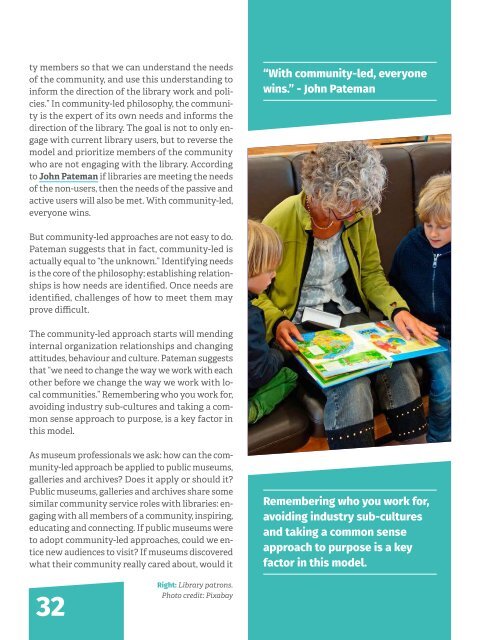Crossing Industries
2015-11-16-roundupIssue263-web-v14
2015-11-16-roundupIssue263-web-v14
Create successful ePaper yourself
Turn your PDF publications into a flip-book with our unique Google optimized e-Paper software.
ty members so that we can understand the needs<br />
of the community, and use this understanding to<br />
inform the direction of the library work and policies.”<br />
In community-led philosophy, the community<br />
is the expert of its own needs and informs the<br />
direction of the library. The goal is not to only engage<br />
with current library users, but to reverse the<br />
model and prioritize members of the community<br />
who are not engaging with the library. According<br />
to John Pateman if libraries are meeting the needs<br />
of the non-users, then the needs of the passive and<br />
active users will also be met. With community-led,<br />
everyone wins.<br />
“With community-led, everyone<br />
wins.” - John Pateman<br />
But community-led approaches are not easy to do.<br />
Pateman suggests that in fact, community-led is<br />
actually equal to “the unknown.” Identifying needs<br />
is the core of the philosophy; establishing relationships<br />
is how needs are identified. Once needs are<br />
identified, challenges of how to meet them may<br />
prove difficult.<br />
The community-led approach starts will mending<br />
internal organization relationships and changing<br />
attitudes, behaviour and culture. Pateman suggests<br />
that “we need to change the way we work with each<br />
other before we change the way we work with local<br />
communities.” Remembering who you work for,<br />
avoiding industry sub-cultures and taking a common<br />
sense approach to purpose, is a key factor in<br />
this model.<br />
As museum professionals we ask: how can the community-led<br />
approach be applied to public museums,<br />
galleries and archives? Does it apply or should it?<br />
Public museums, galleries and archives share some<br />
similar community service roles with libraries: engaging<br />
with all members of a community, inspiring,<br />
educating and connecting. If public museums were<br />
to adopt community-led approaches, could we entice<br />
new audiences to visit? If museums discovered<br />
what their community really cared about, would it<br />
Remembering who you work for,<br />
avoiding industry sub-cultures<br />
and taking a common sense<br />
approach to purpose is a key<br />
factor in this model.<br />
32<br />
Right: Library patrons.<br />
Photo credit: Pixabay


